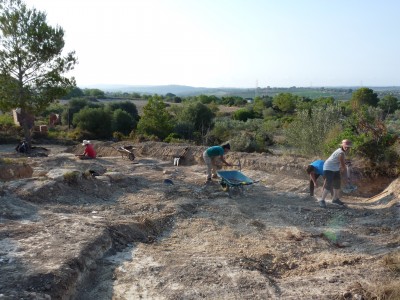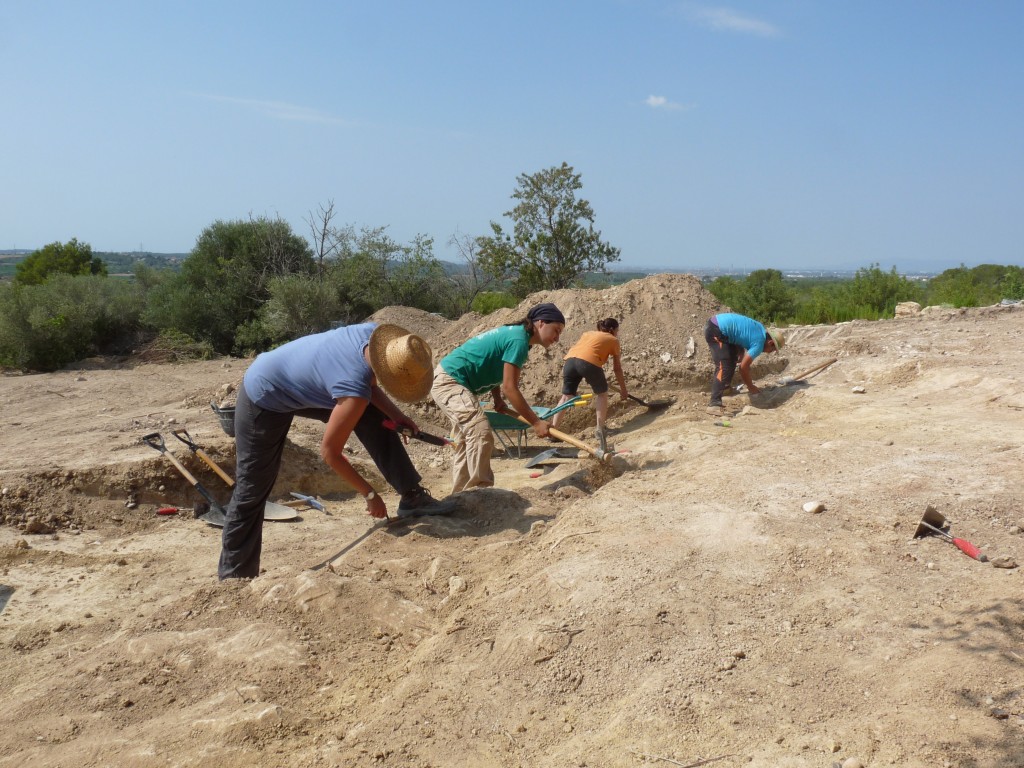
A new campaign of archaeological works has begun in the Late Republican fort Costa de la Serra (La Secuita, Tarragona).
This archaeological site is in La Secuita, 13 km north of the city of Tarragona. It is a small Late Republican Roman fort, dating from the end of the 2nd century BC and the beginning of the 1st century BC.
Different archaeological interventions led by ICAC since 2014 have revealed the existence of a military settlement that was intentionally destroyed at the time of its abandonment.
The fort would have been in use for a short time, most likely during the Sertorian war (80 BC – 72 BC). Different stretches of the wall and towers have been documented, as well as different wall sections that would belong to barracks. There have been also recovered three water tanks for collecting rainwater, with a canalization system partially covered by slabs, probably linked to a water management system.
From June 28 to July 17, a planned intervention is carried out by a small fieldwork team, made up of ICAC researchers, students of the Master in Classical Archaeology and volunteers.
Overall research in this archaeological area is part of a broader project funded by the Catalan government (four-year-long project call), led by Dr Maria Carme Belarte (ICREA-ICAC) and Dr Joan Canela (ICAC), on the evolution and population of Western Cessetani settlements. The project itself is a continuation of a previous one, also based on the research topic of Cessetani protohistoric settlements.
Archaeological fieldwork in Costa de la Serra began in 2015 and, since then, an annual campaign has been carried out, by different work teams, under the direction of ICAC researchers Maria Carme Belarte (ICREA-ICAC), Joan Canela, Jordi López and Núria Otero.

Restrictions due to COVID-19 situation avoid overnight stays and, while it has been possible to maintain the usual duration of the archaeological works (three weeks), the work team has been reduced in order to guarantee safety distances.
The work team is made up of eight people. In addition to the leading researchers (those listed above: Maria Carme Belarte (ICREA-ICAC), Joan Canela, Jordi López and Núria Otero), there are also participating an ICAC’s PhD researcher (Oriol Cuscó), a student of the master in Classical Archaeology, and two former students from the same master (Marc Dalmau and Graciella Pereda).
One of the volunteers now in the work team, Marc Dalmau, a former student of the Master in Classical Archaeology, is the one who discovered the site!
The 2019 archaeological campaign confirmed that the southern stretches of the wall were almost entirely preserved (a total of 40 metres in length), with maximum power, at certain points, of up to three rows of ashlars. It was also verified that the tower located at the southeast end of the complex had twice the area initially verified, going from 50 to 100 m2.
The 2020 archaeological fieldwork will also focus on the southern sector of the site, aiming to complete the delimitation begun in 2019 and to describe this section of the archaeological site. With this delimitation, site excavation works could practically be completed. Thus, the 2021 campaign (corresponding to the last year of the four-year-long project) would focus above all on the consolidation of structures.
Although the archaeological site is very severed and retains very little stratigraphy, the 2020 planned archaeological works will lead to the complete restoration of the plant and the structure of the military building, which corresponds to a characteristic settlement model of the Roman-Republican period in the northeast of the Iberian Peninsula.
Besides the Catalan Government funding, the archaeological fieldwork has the financial support of the City Council of La Secuita (Tarragona).

More information at:





